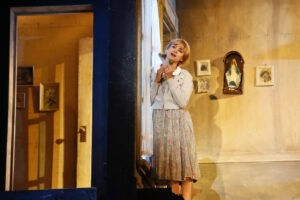
Opera Australia 2022-23 Review: Rigoletto
By Gordon Williams(Photo credit: Jeff Busby)
Elijah Moshinsky’s 1991 production of “Rigoletto” has been seen a number of times in Sydney since its first performance season, and so it would be unsurprising if the recent season at Sydney Opera House, which began on June 13, restaged by Shane Placentino, attracted the odd suggestion that it is time to retire this version.
The internationally-acclaimed Australian director Moshinsky died only in 2021 and though regular opera audiences may hanker for new perspectives, this production is always going to be new to someone. There were at least three people in my proximity on this Tuesday night who had never seen this production (and maybe work) before. They responded audibly as the “curtain went up” (more like an aperture opening) on Michael Yeargan’s set for the Duke’s Mantuan court and at first awareness of the revolving stage that enabled Moshinsky’s cinema-inspired segues between scenes.
Mixed Bag
Of course, there was also reaction to the actual work. “Oh no,” said my companion on the night, at the moment when Gilda, performed by Australian soprano Stacey Alleaume, announced her intention to substitute herself for the no-good Duke, performed by Brazilian tenor, Atalla Ayan, who is actually the target of her father Rigoletto’s murderous revenge. The jaunty melody to which the Duke hypocritically sings of women’s fickleness, “La donne è mobile,” also provoked a response, along with its ironic lyrics. But, surely the surtitler deserved a credit? I couldn’t find a name in the program booklet, though the surtitle operators’ names were there.
“Responded audibly” at sight of the stage picture? Is this an example of audiences humming the sets, a common criticism of modern-day musicals? But there were many other plusses to Moshinsky’s production. Those cinematic “cutaways” augmented the 1950s Italian film vibe, which was an intelligent update from Verdi’s Renaissance-era Mantuan court.
Perhaps it was too much that the “innocent” Gilda snuck a swig of alcohol while at home under the overly-protective gaze of a father worried for her safety while his employer and noted lecher, the Duke, is on the prowl. But, there were other wonderful bits of business. Rigoletto (Ernesto Petti) made multiple uses of his cane, for example, to walk (because Rigoletto is disabled), to lift up the hem of a woman’s dress (because Rigoletto is a prankster), and to detain someone he wished to talk to (there’s something menacing about this character, too, even though the Duke is the villain of the piece).
Perhaps most impressive were the moments of cinematic mise-en-scène. The famous Act three quartet, “Bella figlia dell’amore,” where four different viewpoints are simultaneously presented by Verdi, is an obvious candidate for such treatment. Another clever instance took place in Act one scene two, when the lascivious Duke (Atalla Ayan) climbed up an outside downpipe to alight on the second floor of Rigoletto’s house, while maid Giovanna (Sian Sharp) was visible elsewhere on the premises and Rigoletto and Gilda were downstairs.
Musical Exhiliration
Italian conductor Renato Palumbo’s reading of the score illuminated moments which underlined Verdi’s use of a dark tint for this somber story. But, there was also a telling briskness to some of the tempi. The bounce under the Duke’s boastful “Questa o quella,” this girl or that are all the same to me, made it all the more callously indifferent. And the exhilarating rush into Rigoletto and Gilda’s duet, “Figlia/ Mio padre,” on Rigoletto’s home arrival really conveyed the intensity of their feeling for each other, father and daughter.
In the title role, Italian baritone Ernesto Petti was best at returning to moments of hauntedness, especially after Rigoletto was cursed by Monterone and obsessively reiterates, “Quel vecchio maledivami!” It was as if that horrified hushed sound was a pool of despair that he couldn’t help but return to. Nevertheless, Petti’s scourging of the courtiers who have blithely secreted his daughter away with the Duke in Act two was effectively surly.
Ayan conveyed impressive braggadocio in his portrayal of the loathsome Duke, if not projecting a totally predatory menace. Australian-Mauritian soprano Stacey Alleaume, as Gilda, was the show’s main focus. Her “Caro nome” was a musical event in itself. Her top notes, with which she capped off several numbers, provided the vocalistic thrills demanded by aficionados. Her voice also cut through in the Act three quartet, though singing more quietly than the others, of her continuing love for the no-good Duke, even as her father and the assassin, Sparafucile (Italian bass, Roberto Scandiuzzi), draw our attention to the Duke’s pending demise. In the midst of this ensemble Alleaume’s focus reminded us that it is Gilda’s fate that has our concern.
In supporting roles, mezzo-soprano Sian Sharp provided nicely etched portraits of Giovanna, the maid, and Maddalena, the assassin Sparafucile’s sister, newly enamored of the Duke, her brother’s contracted kill. Sharp always makes the most of these comprimario roles. Bass David Parkin, as Monterone the condemned courtier, made the breast-rising maximum of his crucial moment, while uttering the curse that haunts Rigoletto for the rest of the opera. Paul Fitzsimon prepared the chorus. The males were such an active ingredient of this particular story. Fitzsimon was even pulled out of the ensemble by Palumbo for a much-deserved bow on opening night.
Should this more-than-30-years-old production be retired? Perhaps for the sake of regulars, if not the newcomers. This is the price we pay for live theater’s ability to constantly replenish itself. However, it was good to see this production one more time.


